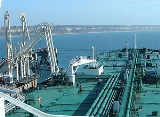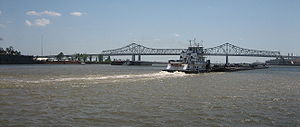
Marine transfer operations
Encyclopedia
Marine Transfer Operations are conducted at many ports around the world between tanker ships, barges, and marine terminals. Specifically, once the marine vessel is secure at the dock a loading arm
or transfer hose is connected between a valve header on the dock and the manifold header on the vessel. A marine transfer of petroleum products cannot be conducted unless it is supervised by a person-in-charge (PIC) on the vessel who is seafarer in the Merchant Marine and another person-in-charge on the dock.
-PIC and the person-in charge on the barge will be the Tankerman-PIC who possesses a merchant mariner's document
. Additionally, the person-in-charge on a tanker ship will be the deck officer who monitors the transfer of product in the cargo control room. Transfer operations and commencement of a transfer is highly regulated throughout the world with consideration of the environment with potential of water pollution
occurring if petroleum product is released into the water during the transfer. Federal, state, and local laws must be observed during marine transfer operations. Additionally, all persons-in-charge must have special training in order to obtain the proper credentials such as licensing and endorsement on their merchant mariner documents.

 Loading Masters work closely with the marine surveyor in agreeing to the sequence of the transfer. Such as whether any product sampling will take place prior to commencement, determining if a line displacement will occur, agreeing on whether the final stop at completion will either be a shore stop or a draft stop on the vessel. The marine surveyor gauges the vessel's tanks and shore tanks to ensure the correct amount of product is transferred. Additionally, the surveyor or inspector will obtain product samples on the marine vessel and shore tank for laboratory analysis to ensure that the product meets all specifications of purity.
Loading Masters work closely with the marine surveyor in agreeing to the sequence of the transfer. Such as whether any product sampling will take place prior to commencement, determining if a line displacement will occur, agreeing on whether the final stop at completion will either be a shore stop or a draft stop on the vessel. The marine surveyor gauges the vessel's tanks and shore tanks to ensure the correct amount of product is transferred. Additionally, the surveyor or inspector will obtain product samples on the marine vessel and shore tank for laboratory analysis to ensure that the product meets all specifications of purity.
, occupational safety and health
regulations must be adhered to in addition to environmental regulations during marine transfer operations. These regulation's are enforced by local state port control organizations such as the United States Coast Guard in the United States.
Loading arm
A loading arm permits the transfer of liquid or liquefied gas from one tank to another through an articulated pipe system consisting of rigid piping and swivel joints to obtain flexibility....
or transfer hose is connected between a valve header on the dock and the manifold header on the vessel. A marine transfer of petroleum products cannot be conducted unless it is supervised by a person-in-charge (PIC) on the vessel who is seafarer in the Merchant Marine and another person-in-charge on the dock.
Person-In-Charge
The person-in-charge on the dock is called a Loading masterLoading master
The loading master person-in-charge is the marine transfer operator at the marine terminal who supervises the movement of petroleum products between tanker ships, barges, and the terminal while the vessel is berthed at the dock...
-PIC and the person-in charge on the barge will be the Tankerman-PIC who possesses a merchant mariner's document
Merchant Mariner's Document
Countries with a Merchant Navy or Merchant Marine require identifying credentials for their mariners. The Merchant Mariner's Document or Z-card in the United States, and the Ordinary Seaman's Certificate in the United Kingdom are examples of these credentials.-United Kingdom:An Ordinary Seaman...
. Additionally, the person-in-charge on a tanker ship will be the deck officer who monitors the transfer of product in the cargo control room. Transfer operations and commencement of a transfer is highly regulated throughout the world with consideration of the environment with potential of water pollution
Water pollution
Water pollution is the contamination of water bodies . Water pollution occurs when pollutants are discharged directly or indirectly into water bodies without adequate treatment to remove harmful compounds....
occurring if petroleum product is released into the water during the transfer. Federal, state, and local laws must be observed during marine transfer operations. Additionally, all persons-in-charge must have special training in order to obtain the proper credentials such as licensing and endorsement on their merchant mariner documents.

Marine Surveyor

Regulations
Maritime Security (USCG)Maritime Security (USCG)
Maritime security is concerned with the prevention of intentional damage through sabotage, subversion, or terrorism. Maritime security is one of the three basic roles of the United States Coast Guard has gradually developed in response to a series of catastrophic events, which began in 1917.There...
, occupational safety and health
Occupational safety and health
Occupational safety and health is a cross-disciplinary area concerned with protecting the safety, health and welfare of people engaged in work or employment. The goal of all occupational safety and health programs is to foster a safe work environment...
regulations must be adhered to in addition to environmental regulations during marine transfer operations. These regulation's are enforced by local state port control organizations such as the United States Coast Guard in the United States.

